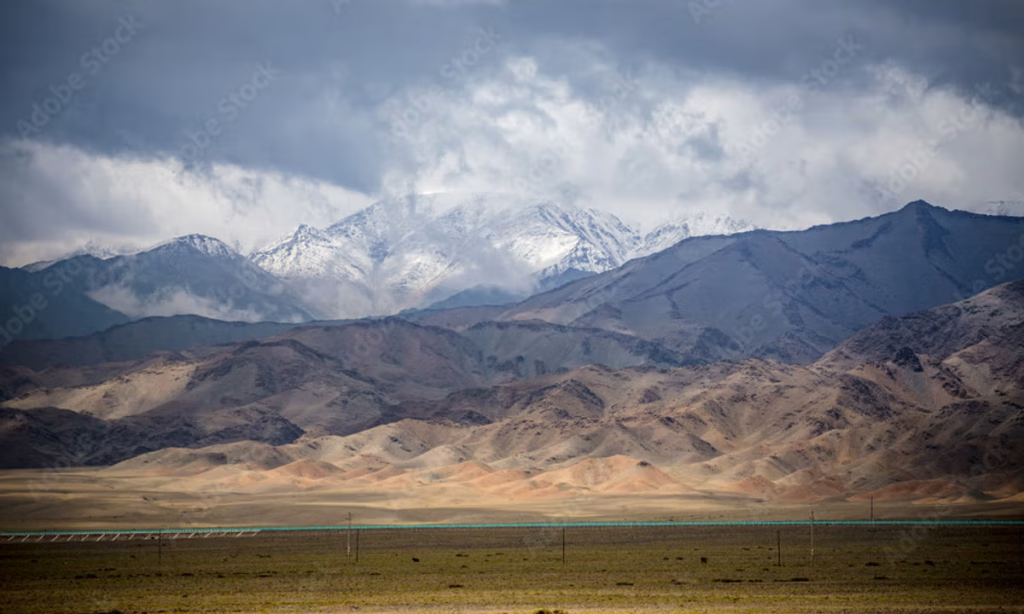A group of artists, curators and gallerists from Xinjiang—the autonomous zone in far western China—have criticised an exhibition held during the summer in Beijing, accusing it of “slip[ping] into cultural appropriation and misrepresentation, at times even reinforcing ethnic stereotypes”.
The exhibition, Greetings, featured the work of the Beijing-based artist Dan Er, and was held at the Maca Art Center from 22 March to 15 June 2025. It focused on Dan’s travels through Xinjiang and interactions with its heritage arts.
Xinjiang is known domestically for its scenery and resources, but known globally for being a site of alleged forced labour and other human rights abuses, where the local culture of its mostly Muslim Uyghur and 46 other indigenous ethnic groups is being erased.
In a statement published on Pailang Museum, a bilingual webzine about indigenous issues in Asia, at the end of July, the anonymous cross-ethnic Xinjiang collective Yixak claim that “no one on the [Greetings] exhibition team appear[ed] to have any familiarity with the language—or the culture—it gestures towards“.
Greetings incorporated Uyghur dance, architecture and textile patterns and techniques. Yixak’s complaints about the show include that it allegedly conflated the cultures of Xinjiang’s ethnic groups, stripped Adras textile patterns of context and significance, and mislabelled and redefined Xinjiang traditions such as those relating to Aywan architecture. The group claimed the show made inaccurate generalisations, including the suggestion that all Xinjiang women can be addressed as “guli”, or flower. Yixak’s article also claimed the show did not credit Dan’s collaborators in Xinjiang and broadly excluded the communities depicted.
Yixak maintains anonymity because of the risks involved in all advocacy for Xinjiang culture in China. It says most of its members were born and raised in Xinjiang, and work in professional fields including including contemporary art, architecture, law, editing, gaming, international relations, government sociology and data analysis. Their ethnicities include Uyghur, Kazakh, Mongolian, Xibe and Han Chinese.
The group explains to The Art Newspaper that it was compelled to speak out after reading reviews in Chinese-language media that included major errors about Xinjiang culture, and which gave the sense that Dan was Uyghur—when she is in fact from China’s dominant Han ethnicity. Some members of the group also saw the show in person.
“Some of us felt there was something off about this exhibition; there were lots of stereotypical statements and factual mistakes,” Yixak says. Its Uyghur members felt deeply offended, it says. The group then reached out to friends with different backgrounds about their concerns, and “what began as casual chats soon sparked a cross-disciplinary, multi-ethnic discussion”.
Both Dan Er and Maca declined to comment on the accusations, writing to The Art Newspaper: “Both the artist and the institution feel very regretful, because under the current circumstances, due to certain very specific and irresistible factors, neither the institution nor the artist is able to respond to this matter directly.”
Maca also did not respond to queries as to whether anyone from Xinjiang, of any ethnicity, was involved in the exhibition. Yixak says it does not see anyone with that background in the project’s published credits. “Perhaps MACA initially placed too much trust in Dan Er’s perspectives on Xinjiang—do they really believe the ideas of Xinjiang locals don’t matter?,” the group says.
Following the initial controversy, Maca held a symposium about cultural appropriation, which also allegedly lacked representation from communities in Xinjiang—the only associated participant being a Han Chinese painter from central China who had briefly studied in the northern region. Yixak say that it is unhappy that the painter “pos[ed]as a spokesperson for Xinjiang artists”.
A handful of artists, galleries and curators have emerged in Xinjiang over the past decade, as well as government-backed initiatives including a short-lived Xinjiang Biennale. “In terms of contemporary art, it’s very small,” says Yixak. “There is a group of Han artists and professionals active around the globe that are from Xinjiang, but fewer ethnic individual working in this field. We seek opportunities just like anybody else.”
Though Chinese cultural uniformity is a myth, perceived differences tend to group around subculture and region more than ethnicity, and ideas such as appropriation are not widely discussed in the country’s art world. Yixak continues: “We believe that most of the contemporary art institutions in China lack knowledge [around issues of] of diversity, differences and identity issues in the country.”
